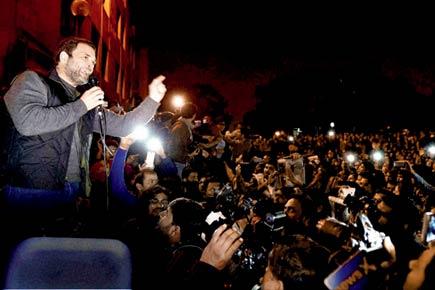Although the JNU fracas presented ample opprtunity, the Congress scion failed to emerge as a leader who can energise and inspire his party troops

 The sedition charge at Jawaharlal Nehru University (JNU) and the frightening violence against academics and journalists at New Delhi’s Patiala House courts have made heroes out of Sturmmann Vikram Singh Chauhan, who is as much a lawyer as Lal Krishan Advani was once a journalist, and of peace neo-icon Kanhaiya Kumar, who overnight achieved what Prakash Karat as CPI-M boss could not: a revival of the Left. The would-be hero who missed out on his moment, however, was the invisible Mr Rahul Gandhi.
The sedition charge at Jawaharlal Nehru University (JNU) and the frightening violence against academics and journalists at New Delhi’s Patiala House courts have made heroes out of Sturmmann Vikram Singh Chauhan, who is as much a lawyer as Lal Krishan Advani was once a journalist, and of peace neo-icon Kanhaiya Kumar, who overnight achieved what Prakash Karat as CPI-M boss could not: a revival of the Left. The would-be hero who missed out on his moment, however, was the invisible Mr Rahul Gandhi.
ADVERTISEMENT

During the incidents involving Rohith and Kanhaiya, Rahul did as expected — he visited each campus, showed sympathy, issued statements, raised slogans, etc. But for practical purposes, he was invisible. File pic
In 2016, Prime Minister Narendra Modi’s government has faced crisis after crisis, starting with terrorism at Pathankot’s airbase and the latest being the Jat agitation for reservations. A crisis defines leadership; its handling shapes the government’s character for the rest of its term. Clearly, in this highly centralised government, no one has the capability (or in the case of some ministers, the desire) to manage a crisis. As the storm following Rohith Vemula’s suicide showed, Modi’s cabinet is afflicted with a foot-in-mouth epidemic. After Pathankot, all other crises were avoidable. And normally, crises like these would blessings-on-a-platter to any political opposition.
Not so with Rahul Gandhi. He has squandered each opportunity to present the simulacrum of leadership that Modi aggressively and successfully presented during the two unpopular final years of Manmohan Singh’s government. When Pathankot happened, Rahul was holidaying abroad. He could have immediately rushed back, publicly demonstrated support to the government till the attack was neutralised, and then launched a political offensive against the government’s ineptitude. He did not.
During the incidents involving Rohith and Kanhaiya, Rahul did as expected — he visited each campus, showed sympathy, issued statements, raised slogans, etc. He even met the President of India. But for practical purposes, he was invisible. On the campuses, he was not taken seriously: if you watched Ravish Kumar of NDTV-India interview JNU students during their rally in Delhi, you’d know why — it’s because the students outshone Rahul with their brilliance. In almost all newspapers, Rahul could not find place on page 1 and had to settle for being buried inside, often ceding prominence on the page to others like Bihar Chief Minister Nitish Kumar. TV news snubbed him.
The Congress appears to be fearful and lacking self-confidence.
It apparently has not gotten over the shock of its massive defeat in the 2014 parliamentary election (as well as in subsequent assembly elections). As vice-president of India’s oldest party, Rahul ought to have long back rallied his troops. It is his job to fill his rank-and-file with hope and optimism, in the way that Modi did for his party during UPA-II’s decline; it is his job to articulate a clear and concise line on each issue so that others down the line can follow his lead.
In 20 months, this hasn’t happened. Instead, in the scant media coverage, Rahul comes across as being as robotic as the Akhil Bharatiya Vidyarthi Parishad (ABVP) rowdies who parrot lines about nationalism and who rampage rather than engage in thoughtful debate. The BJP obviously prefers brawn over brains; Rahul, however, appears to have neither.
A friend says that his colleague met Rahul and returned disappointed, saying: “He is worse than a Baba”. To be termed part of the Babalog — urban, westernised, English-speaking, affluent — is the ultimate insult to any grassroots politician. Here, the insult to Rahul went one step beyond worse. Rahul’s academic qualifications are meagre and post-dated. He shows no signs of being an avid reader or deep thinker, which is why he is not equipped to see complexity in issues; ironically, this is also true of Modi.
These severe words are necessitated by an alarming situation. Vikram Singh Chauhan was allowed to rampage a second and then a third day — possibly because his party is interested in pitting itself against the Left in view of Assembly elections in Kerala and West Bengal, two places where the BJP is desperate to open its account. (A recent pre-poll survey in Kerala says the Left Front will return to power; more surprisingly, BJP will increase its vote-share and, unprecedentedly, take five-six seats.) But in the three years that we have left of Modi, others will want to similarly fast-track their careers in the BJP, and so will resort to similar street violence.
A wall against this nonsense is an imperative. Rahul, though, has not risen to the occasion. Some may argue that sooner or later the money power that toppled Manmohan Singh and propelled Modi, will shift behind Rahul. Then it will not matter if he is a dud.
That seems a tad optimistic, given his dozen years in public life. Kanhaiya Kumar and Vikram Singh Chauhan have started a churning in Indian politics, and if Rahul can’t seize the moment then perhaps he should make way for someone who can.
Journalist and writer Aditya Sinha is the co-author of Kashmir: The Vajpayee Years. He tweets @autumnshade. Send your feedback to mailbag@mid-day.com
 Subscribe today by clicking the link and stay updated with the latest news!" Click here!
Subscribe today by clicking the link and stay updated with the latest news!" Click here!






